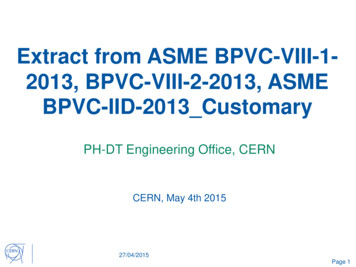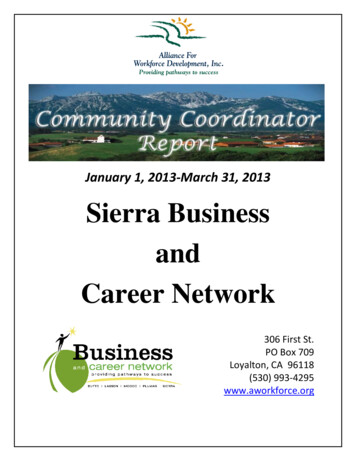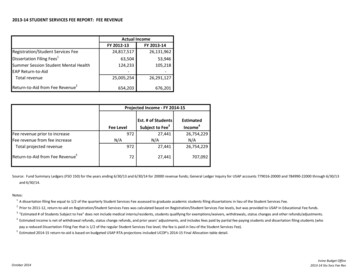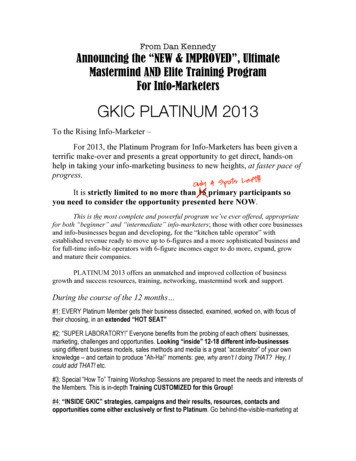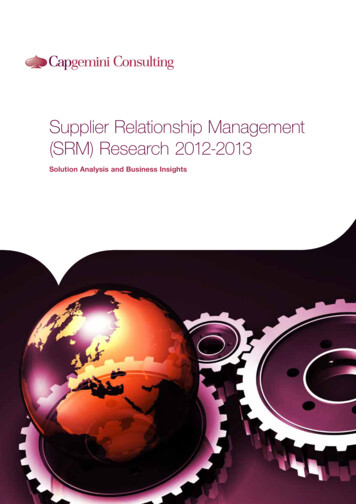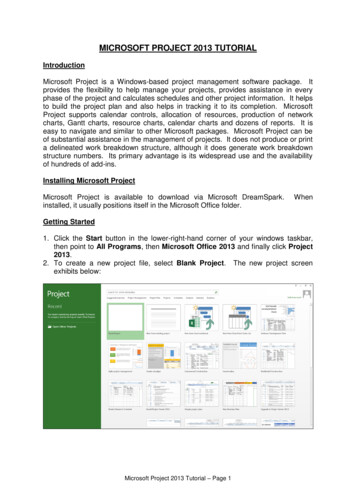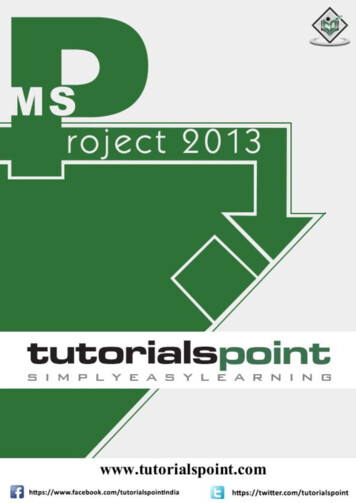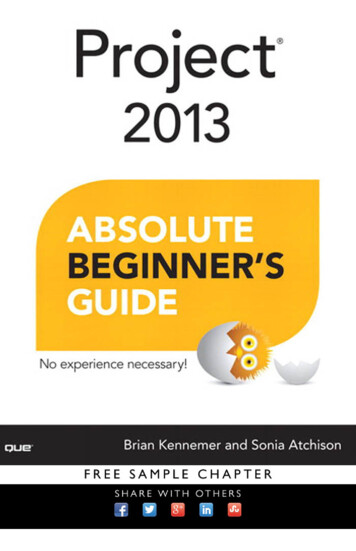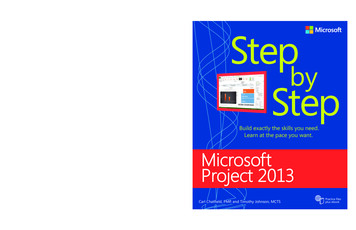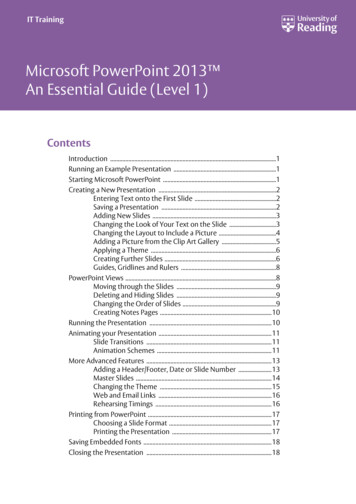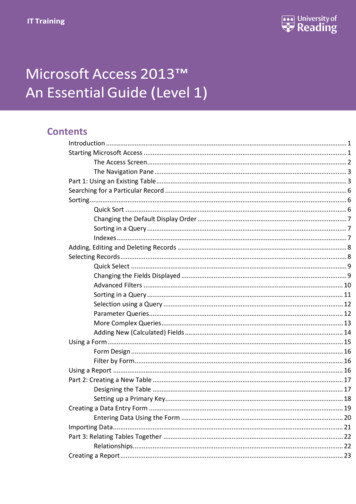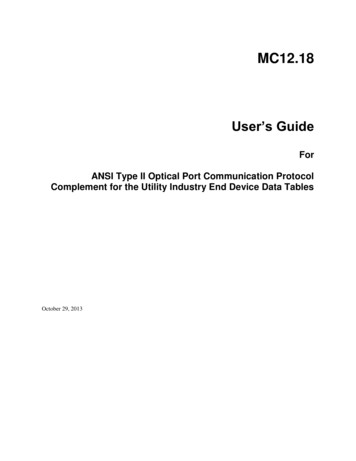
Transcription
MC12.18User’s GuideForANSI Type II Optical Port Communication ProtocolComplement for the Utility Industry End Device Data TablesOctober 29, 2013
MC12.18-2013NOTICE AND DISCLAIMERThis document was prepared by the Future DOS Research & Development Inc. The information in this documentwas considered technically sound by the consensus of persons engaged in the development of the User’s Guide atthe time it was developed. Consensus does not necessarily mean that there is unanimous agreement among everyperson participating in the development of this document.Measurement Canada, members of the Task Force on Data Communications Protocol for Electronic MeteringDevices and Future DOS R&D Inc. disclaim liability for any personal injury, property, or other damages of anynature whatsoever, whether special, indirect, consequential, or compensatory, directly or indirectly resulting fromthe publication, use of, application, or reliance on this document. Measurement Canada disclaims and makes noguaranty or warranty, express or implied, as to the accuracy or completeness of any information contained herein,and disclaims and makes no warranty that the information in this document will fulfill any of your particularpurposes or needs. Measurement Canada does not undertake to guarantee the performance of any individualmanufacturer or seller’s products or services by virtue of this User’s Guide.While Measurement Canada establishes rules to promote fairness for the Canadian industry, it does not write thedocument and it does not independently test, evaluate, or verify the accuracy or completeness of any information orthe soundness of any judgments contained in this User’s Guide.In making this document available, Measurement Canada is not undertaking to render professional or other servicesfor or on behalf of any person or entity, nor is Measurement Canada undertaking to perform any duty owed by anyperson or entity to someone else. Anyone using this User’s Guide should rely on his or her own independentjudgment or, as appropriate, seek the advice of a competent professional in determining the exercise of reasonablecare in any given circumstances. Information and other standards on the topic covered by this User’s Guide may beavailable from other sources, which the user may wish to consult for additional views or information not covered bythis publication.Permission is hereby granted for Measurement Canada Task Force on Data Communications Protocol for ElectronicMetering Devices Committee participants to reproduce this document for purposes of international standardizationconsideration and education. Prior to adoption or publication of this document, in whole or in part, by anotherorganization permission must first be obtained from the Measurement Canada. Other entities seeking permission toreproduce this document, in whole or in part, must also obtain permission from Measurement Canada.MC12.18-2013 was reproduced with the permission of Measurement Canada.Copyright 2013 Her Majesty the Queen in right of Canada.All rights reserved.Contact:Mr. Adnan Rashid, Sr. Engineer.Measurement CanadaStandards Building151 Tunney's Pasture DrivewayOttawa, OntarioK1A 0C9ii
MC12.18-2013Abstract: The technical content of this User’s Guide is nearly identical to IEEE Std 1701 -2011 andANSI C12.18-2006, using IEEE Std 1701-2011 as the baseline for the MC12.18 User’s Guide. Theprotocol provides multi-source and “plug and play” environment for the millions of metering devices in thefield now and the future using the ANSI Type 2 optical port interface. It solves the problems associatedwith single source systems and with multi-source systems based upon proprietary communicationsprotocols. Electric, Water, and Gas Utilities and corresponding vendors can realize cost savings thatultimately shall benefit the client consumers of the Utilities.Keywords: IEEE Std 1701, ANSI C12.18, MC12.18, Optical Port, ANSI Type II, PSEMiii
MC12.18-2013This page is left blank intentionally.iv
MC12.18-2013IntroductionThis introduction is not part of the MC12.18 User’s Guide. For consistency with IEEE Std 1701 and ANSI C12.18 the word“standard” was retained throughout this User’s Guide in reference to this document. Also in reference to MC12.18, MC12.19,MC12.21 and MC12.22, the term “standard” means “User’s Guide”.The ANSI C12.18 and IEEE Std 1701 standard and the MC12.18 User’s Guide provide an open-platformcommunications protocol for two-way communication with an End Device (e.g. a meter) through an ANSI Type 2Optical Port. The protocol is written to conform to the OSI seven-layer stack. Readers of IEEE Std 1701-2011 orANSI C12.18-2006 will discover some editorial corrections were applied in this version of the document in order toaddress deficiencies that were discovered since the publication of ANSI C12.18-2006 and IEEE Std 1701. Each andevery correction is identified were applied and were forwarded to the respective working groups IEEE P1701 andASC 12 SC 17 WG4 for inclusion in future revisions of ANSI C12.18 and IEEE Std 1701.The 2006 version to the ANSI publication of ANSI C12.18, the 2011 version of the IEEE publication ofIEEE Std 1701 and the release of this version of the MC12.18 User’s Guide should be considered in the context ofthe so-called “protocol suite” of standards:a.ANSI C12.18 / MC12.18 / IEEE Std 1701 ,b.ANSI C12.19 / MC12.19 / IEEE Std 1377 ,c.ANSI C12.21 / MC12.21 / IEEE Std 1702 ,d.ANSI C12.22 / MC12.22 / IEEE Std 1703 , ande.Draft ANSI C12.23 / Draft MC12.23 / IEEE P1705 .The ANSI and IEEE published changes were included only after assuring that existing devices implementing ANSIC12.18-1996, ANSI C12.18-2006 and IEEE Std 1701-2011 continue to remain compatible with this version of thedocument.This document corrects an error in the original ANSI C12.18-1996 standard such as the impossibility of using indexcount access methods for table access. It also corrects errors in the description of the parameters of the identification service found in ANSI C12.18-2006 and IEEE Std 1701-2011. Other concepts addressed includecompliance, backward and forward compatibility, the use of reserved fields, the Identification Service, packet sizeand the toggle bit. Finally, some alignment with the equivalent functions found in ANSI C12.22-2012 /IEEE Std 1703-2012 / MC12.22-2013 standard was performed to meet the goal of producing a coherent suite ofprotocol standards.Also note that document describes an optionally exposed point-to-point interface between a C12.18 Device and aC12.18 Client. The terms “C12.18 XXXX” (e.g., C12.18 Device) were introduced by ANSI C12.18-1999. Theseterms can be interchangeably replaced with the terms “IEEE 1701 XXXX” or “MC12.18 XXXX”; i.e., the IEEE1701 Device is the same as the ANSI C12.18 Device and MC12.18 Device. However, since these documents werejointly developed under the auspice of ANSI C12 SC17 WG4, the document terminology is based on C12.18 terms.Therefore references to ANSI or IEEE devices or standards are equivalent to references to the correspondingMC12.xx devices or User’s Guides.Otherwise, this document is identical to the published ANSI C12.18-2006 / IEEE Std 1701-2011 Standards.Notice to usersThe body of this User’s Guide was developed jointly with ANSI C12.18 and IEEE Std 1701. The joint agreementcalls for the standards and regulatory organizations IEEE, ANSI and MC to maintain the body of this standard inv
MC12.18-2013step as they publish versions and revisions of the standard. A number of editorial corrections were made in thepreparation of the MC12.18 User’s Guide after the publication of ANSI C12.18-2006 and IEEE Std 1701-2011.These corrections were incorporated into this User’s Guide and highlighted in the body of the document to indicatethat the text was corrected. The detailed list of corrections is also shown in Annex E - Listing of EditorialCorrections to ANSI C12.18-2006 and IEEE Std 1701.Laws and regulationsUsers of this User’s Guide should consult all applicable laws and regulations. Conformance with the provisions ofthis document does not imply compliance or conformance to any applicable regulatory requirements. Implementersof the User’s Guide are responsible for observing or referring to the applicable regulatory requirements.Measurement Canada does not, by the publication of its documents, intend to urge action that is not in compliancewith applicable laws, and these documents may not be construed as doing so.Updating of documentsUsers of this User’s Guide should be aware that this document may be superseded at any time by the issuance ofnew editions or may be amended from time to time through the issuance of amendments, corrigenda, or errata. Afuture document may at any point in time consist of the current edition of the document together with anyamendments, corrigenda, or errata then in effect. In order to determine whether a given document is the currentedition and whether it has been amended through the issuance of amendments, corrigenda, or errata, visit the EnergyCommunications Management Exchange web site at http://www.ecmx.org.ErrataErrata, if any, for this User’s Guide can be accessed at the following URL: http://www.ecmx.org. Users areencouraged to check this URL for errata periodically.PatentsAttention is called to the possibility that implementation of this User’s Guide may require use of subject mattercovered by patent rights. No position is taken with respect to the existence or validity of any patent rights inconnection therewith. Measurement Canada, members of the Task Force on Data Communications Protocol forElectronic Metering Devices and the publisher of this guide are not responsible for identifying Essential PatentClaims for which a license may be required, for conducting inquiries into the legal validity or scope of PatentsClaims or for determining whether any licensing terms or conditions provided in connection with submission of aLetter of Assurance, if any, or in any licensing agreements are reasonable or non-discriminatory. Users of thisdocument are expressly advised that determination of the validity of any patent rights, and the risk of infringementof such rights, is entirely their own responsibility. The Energy Communications Management Exchange and ECMX are registered trademarks of Future DOS Research &Development Inc.vi
MC12.18-2013ParticipantsAt the time this User’s Guide was completed, the Measurement Canada Task Force on Data CommunicationsProtocol for Electronic Metering Devices had the following membership:Adnan Rashid, Plenary ChairVuong Nguyen, Past Plenary Chair (retired)Avygdor Moise, Technical ainHaynesBradLarryTerry ii
MC12.18-2013viii
MC12.18-2013CONTENTS1Overview . 11.1Scope . 11.2Purpose . 12 Normative References . 13 Definitions and Syntax . 23.1Definitions . 23.2Document Syntax . 34 Protocol Details. 34.1Order of Transmission . 44.2Layer 7—Application Layer . 44.3Layer 6—Presentation Layer . 224.4Layer 5—Session Layer . 224.5Layer 4—Transport Layer . 224.6Layer 3—Network Layer . 224.7Layer 2—Data Link Layer . 224.8Layer-1—Physical Layer . 275 Compliance . 30Annex A - Communication Example (Layer 7 and Layer 2) . 31Annex B - Packet Transmission Example . 33Annex C - Service Sequence State Control . 35Annex D – Compatibility . 37D.1Backward compatibility with previous versions of the Standard .
ANSI C12.18-2006 will discover some editorial corrections were applied in this version of the document in order to address deficiencies that were discovered since the publication of ANSI C12.18-2006 and IEEE Std 1701. Each and every correction is identified were applied and were forwarded to the respective working groups IEEE P1701 and
